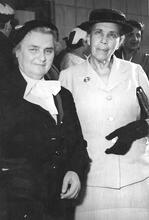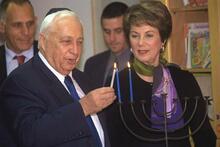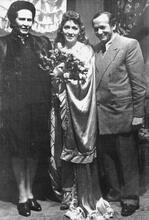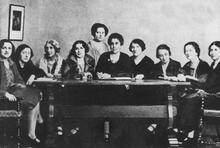Naomi Amir
Naomi Kassan Amir was a pioneer in pediatric neurology in part because of her holistic approach, seeing each child not just in terms of their disability but in the context of their family and their community. After completing medical school in the United States and her residency in Israel, Amir realized a gap needed to be addressed among pediatricians who focused on developmental growth and pediatric neurologists treating chronic handicaps such as epilepsy, autism, and developmental disorders. In Israel, she created the first rehabilitation daycare center for children’s neurological issues, expanding it in the years thereafter. Amir treated both Jews and Arabs at her clinic in Jerusalem and continued running her department until days before her death.
“I may not be perfect, but parts of me are excellent,” read the badge on a big teddy bear physician Naomi Amir gave her young disabled patients to cuddle. The sentiment reflected her medical philosophy, which made her a pioneer in pediatric neurology. She treated children with a wide range of disabilities, including sleep problems, encephalitis, and autism, but her special interests were epilepsy, cognition (including neuro-metabolism), dysphasia, and developmental disorders. In her work, Amir stressed that the infant or child must be seen in the context of his or her Israeli family: Jewish or Arab, secular or religious.
Early life: education and marriage between the US and Palestine
Naomi Kassan Amir was born in Chicago on January 23, 1931, the first daughter and second child of Eva (Dushkin) and Shalom Kassan, an American mother and Palestinian father. Her mother, born into an Eastern European immigrant family, was one of the new generation of Jewish American woman who achieved careers of their own as social workers. Her father belonged to the elite of pre-state Jewish Palestine. At the age of four, her family moved to Palestine, where her father served as a judge in the legal service of the Mandate for Palestine given to Great Britain by the League of Nations in April 1920 to administer Palestine and establish a national home for the Jewish people. It was terminated with the establishment of the State of Israel on May 14, 1948.British Mandate. After a year and a half, her mother and her children returned to the United States for a year. Following a second year in Palestine in 1938, Eva Kassan settled in New York City with the children. Naomi developed a strong bond with her mother during her youth.
After graduating from the Bronx High School of Science, she received her B.A. from New York University and then completed New York University Medical School in 1952. “I always knew I wanted to be a doctor,” she said. “Madame Curie was my role model.” She also never doubted that she could combine marriage with a career or that she would settle in Israel. She came to Israel in 1953 to begin her residency in neurology at the Hadassah-Hebrew University Medical Center. She chose neurology “because it is a human-oriented aspect of science that deals with human functions, with learning and teaching, and with the organization of the brain.” On March 27, 1955, she married Shlomo Amir. They had three children, immediately testing Naomi Amir’s conviction that she could combine marriage, motherhood, and career. Their daughter Anat was born in 1957, followed by two sons, Ilan (b. 1959) and Gideon (b. 1964).
Stepping into pediatric neurology
After completing her residency at Hadassah Hospital in Jerusalem, Naomi Amir decided to specialize in the diagnosis and treatment of children with neurological problems. This new field was not recognized in Israel, but Amir was fortunate to find a mentor in Dr. Helena Kagan, head of pediatrics at Bikur Holim Hospital in Jerusalem. Kagan gave her the support and counsel Amir needed in a medical world where women were a small minority. The religious hospital, serving a large Orthodox clientele, also proved advantageous because she received a small room where she set up her neurological clinic away from the pediatric wards.
Realizing that she needed additional training, Amir took a clinical fellowship at New York’s Neurological Institute of Columbia Presbyterian Medical Center, working with Professor Sidney Carter. There she met a Swiss neurologist, Isabelle Rapin, with whom she subsequently collaborated. They jointly edited Behavior and Cognition of the Child with Brain Dysfunction (1991). Amir spent two years in New York, where she recognized the gap between pediatric neurologists who might diagnose and treat chronic handicaps and pediatricians who concentrated on developmental growth.
Bringing people together: Amir’s work in Israel
When she returned to Israel, in 1968, she was determined to bridge that divide and set up the first pediatric neurology rehabilitation day care center and nursery school. In 1979, she expanded this rehabilitation center for brain-damaged children into a full pediatric neurological service. Amir provided diagnosis, multidisciplinary evaluation, and intervention for static neurological conditions together in one place. Most interested in metabolic changes, Amir worked not just with clinicians administering therapy but only with researchers contributing to the field of neuroscience.
In 1990, Amir moved with her team of seven experts to Sha’arei Zedek Hospital in Jerusalem, which gave her an entire wing in a well-equipped new building. Amir also worked at the Spafford Clinic in the Old City, where she treated Muslim Arab children, and at the Mukassed Hospital on the Mount of Olives. She recognized that parental assessment of a child’s abilities depended on their family history and that effective treatment could not be taken without family screening. She also understood the political dimensions of her medical work. “Even if governments don’t always see eye to eye,” she said “I use my profession to bring people together.”
Dr. Naomi Amir became ill with cancer, but she continued to run the department from her sickbed. Three days before her death on January 4, 1995, she gave precise instructions for the continuation of her work. Many of her patients undoubtedly felt personally bereaved by her loss. A young girl whom she had helped face life with a severe disability wrote in a condolence letter: “She taught me not to feel like a victim.” Naomi Amir gave this gift to thousands of her patients as she established the field of pediatric neurology in Israel.
Amir, Naomi, and Isabelle Rapin. Behavior and Cognition of the Child with Brain Dysfunction (1991).
Israeli Women of Achievement (1989).
Layish, Naomi. Tribute to Dr. Naomi Amir. Memorial Booklet.
Obituary. Jerusalem Post, February 15, 1995.









